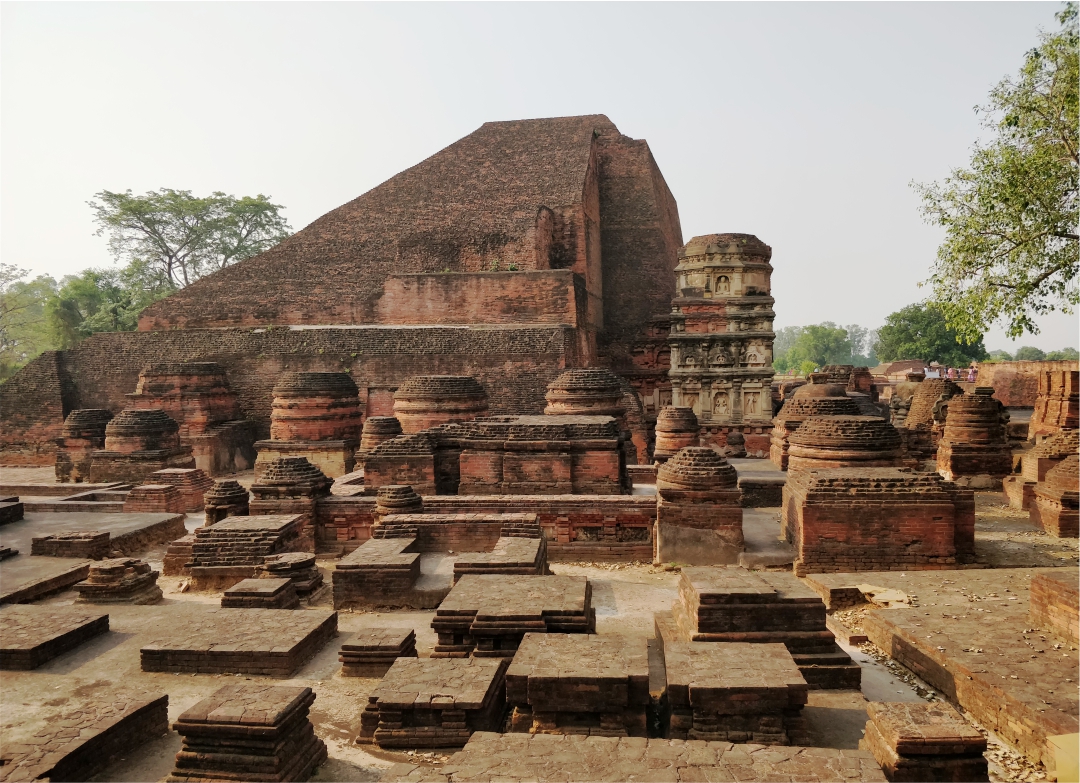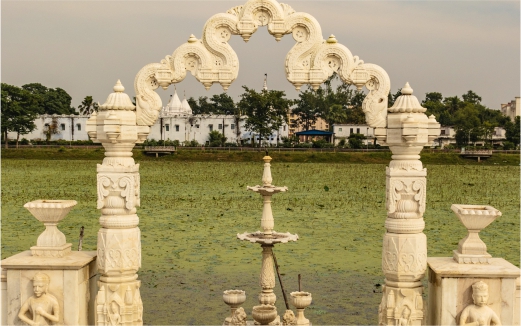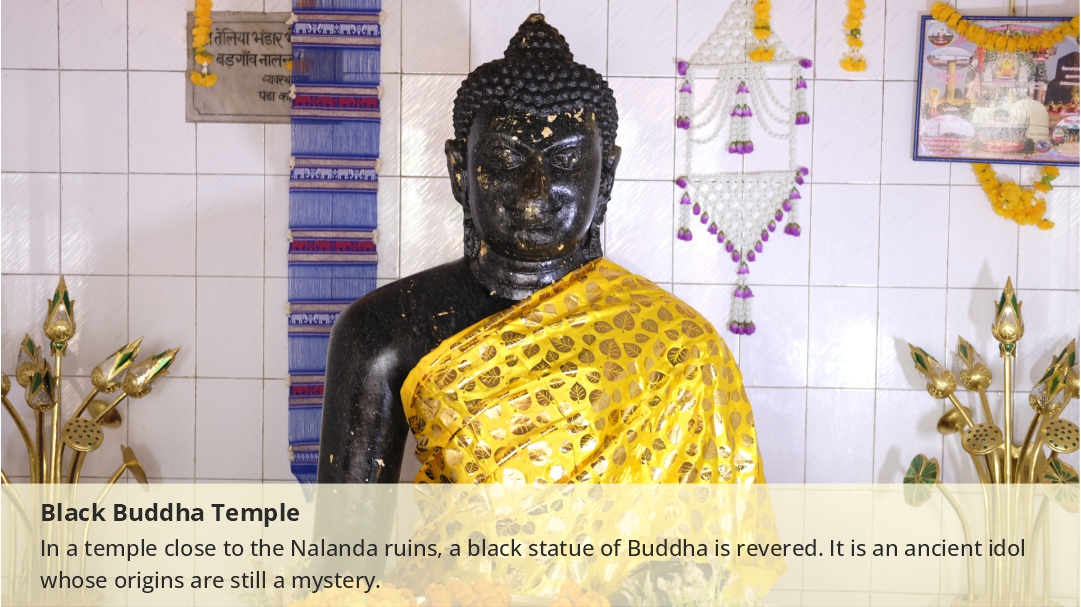Nalanda Ruins, Bihar
Been there recently?
Nalanda was an acclaimed Mahavihara, a large Buddhist monastic university in the ancient kingdom of Magadha (modern-day Bihar state) in India. Between 427 CE and 1197 CE, it served as the first residential university in the world. Between the fifth and sixth centuries CE, known as India’s Golden Age, Nalanda actually took the initiative to promote the arts and academics. Today, the ruins of the university are a UNESCO World Heritage Site. The quaint hamlet scattered with the ruins of one of the greatest educational institutes in history, the Nalanda University, 11 monasteries and six brick temples, the UNESCO World Heritage Site of Nalanda, is steeped in history. Here, one can follow in the steps of Lord Buddha because the area still exudes the grandeur and glory of its former life as a significant Buddhist centre. It stands as a silent witness to the region’s rich history and is dotted with the Mauryan and Gupta dynasties’ cultural legacies.

Nearby Places to See
Jal Mandir
The location of Jal Mandir is a revered and holy place for Jains. It marks the site of Mahavira’s cremation, the 24th and final tirthankara, about 500 years before the modern era. The temple is accessible via a 600-foot stone pathway that runs through the centre of a large pond. Jal Mandir is located in Pawapuri Town, 12 kilometres from Nalanda.
The location of Jal Mandir is a revered and holy place for Jains. It marks the site of Mahavira’s cremation, the 24th and final tirthankara, about 500 years before the modern era. The temple is accessible via a 600-foot stone pathway that runs through the centre of a large pond. Jal Mandir is located in Pawapuri Town, 12 kilometres from Nalanda.

Nalanda Archaeological Museum
Nalanda’s Archaeological Museum is one of the most popular destinations in Bihar and is home to thousands of artefacts. Since its founding in 1917, the museum has taken pride in being one of Rajgir’s first university-cum monastic complexes. The museum’s collection of Buddhist and Hindu bronze artefacts, especially the many statues of the Buddha that have been meticulously preserved, is the museum’s main draw. Two enormous first-century terracotta jars are also on display at the museum. Visitors can also see exhibits of pottery, coins, copper plates, stone inscriptions, and other antiquarian items. The museum’s four galleries house about 349 artefacts from the fifth to the twelfth centuries AD.
Nalanda’s Archaeological Museum is one of the most popular destinations in Bihar and is home to thousands of artefacts. Since its founding in 1917, the museum has taken pride in being one of Rajgir’s first university-cum monastic complexes. The museum’s collection of Buddhist and Hindu bronze artefacts, especially the many statues of the Buddha that have been meticulously preserved, is the museum’s main draw. Two enormous first-century terracotta jars are also on display at the museum. Visitors can also see exhibits of pottery, coins, copper plates, stone inscriptions, and other antiquarian items. The museum’s four galleries house about 349 artefacts from the fifth to the twelfth centuries AD.
Hiuen Tsang Memorial
Built in honour of the well-known Chinese traveller Hiuen Tsang, who arrived at the Nalanda University in 633 AD to study Buddhism and mysticism for a full 12 years, the Hiuen Tsang Memorial Hall is now one of the city’s most popular tourist attractions. The memorial hall now stands where he once studied yoga under his mentor, Acharya Shil Bhadra. Pt. Jawaharlal Nehru began building the hall in January of 1957, and it was completed in 1984. Tsang collected a number of records during his stay that serve as a significant historical source for Buddhist literature. In the memorial hall, these are kept in good condition.
Built in honour of the well-known Chinese traveller Hiuen Tsang, who arrived at the Nalanda University in 633 AD to study Buddhism and mysticism for a full 12 years, the Hiuen Tsang Memorial Hall is now one of the city’s most popular tourist attractions. The memorial hall now stands where he once studied yoga under his mentor, Acharya Shil Bhadra. Pt. Jawaharlal Nehru began building the hall in January of 1957, and it was completed in 1984. Tsang collected a number of records during his stay that serve as a significant historical source for Buddhist literature. In the memorial hall, these are kept in good condition.

Kundalpur
One of the most significant Jain pilgrimage sites is Kundalpur, which is situated on the outskirts of Nalanda. Lord Mahavira, the founder of Jainism and the final tirthankar (saint), is said to have been born there. A four-and-a-half-foot-tall Lord Mahavira idol has been erected in a nearby temple as a marker for the location. The Trikal Chaubeesi Jain Mandir, which houses 72 idols of tirthankaras, is located within the same complex. There are 24 saints represented here, from the past, the present, and the future. The Nandyavarta Mahal, a seven-story structure thought to be the birthplace of Lord Mahavira, is another notable landmark in Kundalpur.
One of the most significant Jain pilgrimage sites is Kundalpur, which is situated on the outskirts of Nalanda. Lord Mahavira, the founder of Jainism and the final tirthankar (saint), is said to have been born there. A four-and-a-half-foot-tall Lord Mahavira idol has been erected in a nearby temple as a marker for the location. The Trikal Chaubeesi Jain Mandir, which houses 72 idols of tirthankaras, is located within the same complex. There are 24 saints represented here, from the past, the present, and the future. The Nandyavarta Mahal, a seven-story structure thought to be the birthplace of Lord Mahavira, is another notable landmark in Kundalpur.
Stupa of Sariputra
The most recognizable of Nalanda’s remaining structures is the Nalanda Stupa, also referred to as the Sariputra Stupa. It is the most significant structure in Nalanda and a UNESCO World Heritage Site, serving as evidence of the city’s rich cultural heritage. The great Nalanda Stupa is a pyramid-shaped stupa that was constructed in the third century by Mauryan emperor Ashoka in honour of Buddha’s disciple Sariputra. On either side of the building are stunning sculptures and votive stupas. Bricks were used to construct these votive stupas, and passages from revered Buddhist writings were inscribed on them. The stupa is surrounded by a number of flights of stairs that lead to its peak.
The most recognizable of Nalanda’s remaining structures is the Nalanda Stupa, also referred to as the Sariputra Stupa. It is the most significant structure in Nalanda and a UNESCO World Heritage Site, serving as evidence of the city’s rich cultural heritage. The great Nalanda Stupa is a pyramid-shaped stupa that was constructed in the third century by Mauryan emperor Ashoka in honour of Buddha’s disciple Sariputra. On either side of the building are stunning sculptures and votive stupas. Bricks were used to construct these votive stupas, and passages from revered Buddhist writings were inscribed on them. The stupa is surrounded by a number of flights of stairs that lead to its peak.


-
Destination



